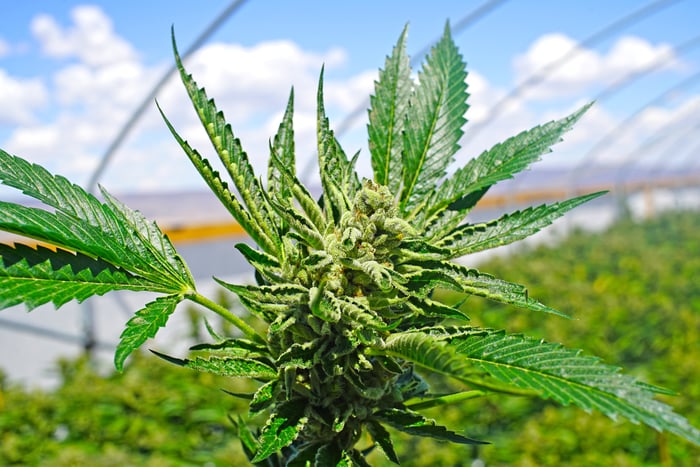In case you've been living under a rock, the marijuana industry, and stocks associated with marijuana, have been on fire. The success of weed businesses and marijuana stocks are a direct result of a shift in public opinion toward cannabis, and a softening stance among select state governments that are eager to generate new revenue.
For instance, a 2016 Gallup poll and a 2017 CBS News poll found that 60% and 61% of respondents, respectively, want to see recreational pot legalized nationwide. Both figures represent all-time highs, which is a major reason why so many weed initiatives voted on by the public in the November 2016 elections wound up passing.

Image source: Getty Images.
We've also seen state legislatures step up to legalize cannabis. Both Ohio and Pennsylvania legalized medical pot last year without putting their respective measures on a ballot. In Colorado, combined recreational and medicinal sales topped $1.3 billion in 2016, up more than 30% from the previous year, as tax revenue and licensing fees neared $200 million. This extra capital isn't going to patch a huge budget deficit, but it is providing new funding for schools, law enforcement, and in-state drug-abuse programs.
Three statistics that define the "green rush"
Amazingly, though, the marijuana industry and pot stocks could just be getting started. Here are three figures that perfectly sum up the buzz currently surrounding weed and marijuana stocks.
1. An estimated $17 billion in retail sales by 2021
According to the recently released Marijuana Business Factbook 2017 from Marijuana Business Daily, retail sales of weed are expected to triple between 2017 and 2021. Growth in 2017 for legal sales is expected to come in between $5.1 billion and $6.1 billion, representing 30% year-on-year improvement. However, retail sales are expected to soar 45% in 2018, reach around $11 billion in 2019, and possibly top $17 billion by 2021. That's truly phenomenal growth.
But if we take a step back, this growth isn't entirely unexpected. There are 20 states with existing legal medical pot infrastructure (to a varying degree) that haven't legalized recreational weed, so taking things one step further by making recreational cannabis legal isn't that far-fetched, especially with states like Colorado, Washington, and Oregon leading by example.
Also, recreational sales are expected to top medical sales for the first time ever this year.

Image source: Getty Images.
2. An economic impact of $70 billion by 2021
Another really intriguing statistic to come out of the Marijuana Business Factbook 2017 was the estimate that the marijuana industry's economic impact could grow threefold between now and 2021. In other words, a $20 billion to $24 billion economic impact in 2017 could grow to $70 billion by 2021.
The simple fact that there's more to the marijuana industry than just retailers selling product to consumers is an important point that often gets overlooked. For example, the pot industry is responsible for creating jobs (financing, consulting, growing, courier, and more), which leads to disposable income that consumers put back into their local economy. The rise of recreational marijuana has also led to pot-based tourism, which can inject growth into the economies of Colorado, Washington, Oregon, and other legal recreational weed states. There's even the potential that banks may one day have restrictions lifted, allowing them to provide basic banking services, including loans, to the cannabis industry.
Long story short, the weed business is about far more than just retail sales and the consumer.
3. An average gain of 450% over the trailing 12 months
And, of course, the most direct evidence of the success of the pot industry is the average return of marijuana stocks over the trailing year. The 12 largest marijuana stocks by market cap (including those with more indirect associations with pot industry) have increased in value by an average -- I repeat, an average -- of 450% over the trailing 12-month period.
Admittedly, AXIM Biotechnologies (AXIM -3.23%), a clinical-stage biotech company looking to market its chewable and topical cannabis products across more than a dozen indications, is a big reason why pot stocks are up so much as a collective. Its trailing 12-month return is 3,809%! The company's share price rose from the dead in October after announcing private funding that allowed its clinical research to continue.

Image source: Getty Images.
However, even if we remove AXIM from the equation, the largest 11 marijuana stocks by market cap have risen an average of 144.7% over the trailing 12-month period. That leaves the broader stock market in the dust!
Among the top performers are growers and retailers for the Canadian medical cannabis industry. Canopy Growth Corp. (CGC 1.28%), Aphria (NASDAQOTH: APHQF), and Aurora Cannabis (ACB -1.15%), are up 204%, 285%, and 452%, respectively, over the trailing 12-month period.
Why the excitement? To begin with, Aphria, while small, has produced five consecutive profitable quarters, while Canopy Growth remains on track to deliver a full-year profit in 2017.
More importantly, all three growers and retailers are working on major expansions of their growing capacity to take advantage of an increase in medical cannabis demand, and to be prepared in case Canada moves forward with a bill to legalize recreational weed. Canopy Growth recently acquired 472,000 square feet around its corporate headquarters. Meanwhile Aphria and Aurora Cannabis are working on organic expansions. Aphria's Phase IV expansion will push its grow capacity to 1 million square feet, while the Aurora Sky project is expected to add 800,000 square feet of grow capacity for Aurora Cannabis.

Image source: Getty Images.
One overarching figure
However, there's one all-important statistic that marijuana businesses and marijuana investors also need to be aware of: the number 1... as in the current scheduling of cannabis at the federal level.
The federal government's schedule 1 status on marijuana means it offers no medical benefits and is an illicit substance. It also means that marijuana-based businesses face a number of disadvantages, such as the inability to take normal corporate tax deductions and difficulty securing basic banking services, including something as simple as a checking account.
As long as the federal government keeps its schedule 1 status on marijuana, the sky is not the limit for the industry or marijuana stocks. And with an ardent opponent of pot like current Attorney General Jeff Sessions, it looks increasingly unlikely that major advancements will be made at the federal level under the Trump administration.
Translation? You might be better off distancing yourself from marijuana stocks despite their recent performance.




